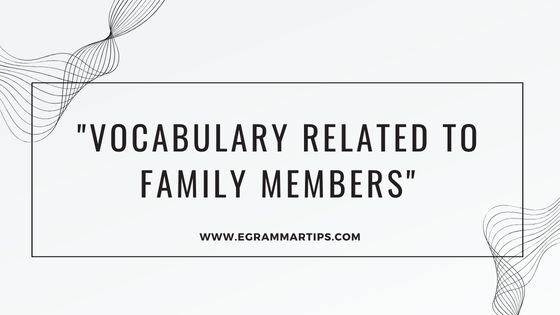
Family is a fundamental part of our lives, and understanding the different roles and relationships within a family can help us appreciate the bonds we share with those closest to us. Here’s a detailed explanation of common family members and their relationships:
1. Immediate Family Members
These are the family members who are most closely related to you, usually living in the same household or closely connected by blood or legal ties.
•Parents:
° Father (Dad): The male parent. He is typically seen as one of the primary caregivers and providers for the family.
° Mother (Mom): The female parent. Like the father, she plays a key role in nurturing and raising children.
•Siblings:
° Brother: A male sibling. Brothers can be older or younger, and the relationship between siblings can vary widely, ranging from close friendships to typical sibling rivalry.
° Sister: A female sibling. Sisters can also be older or younger, and often share a close bond, providing support and companionship throughout life.
•Children:
° Son: A male child. Parents are responsible for raising and caring for their sons, guiding them through childhood into adulthood.
°Daughter: A female child. Like sons, daughters are raised by their parents and share a unique bond with them.
2. Extended Family Members
These are relatives who are not part of the immediate family but are still connected through blood or marriage.
•Grandparents:
° Grandfather (Grandpa): The father of your father or mother. Grandfathers often play a special role in the family, passing down wisdom and traditions.
° Grandmother (Grandma): The mother of your father or mother. Grandmothers are often cherished for their nurturing nature and for keeping family traditions alive.
•Grandchildren:
° Grandson: The male child of your son or daughter. Grandparents often share a special bond with their grandchildren, enjoying a different dynamic than with their own children.
° Granddaughter: The female child of your son or daughter. Like grandsons, granddaughters are often adored by their grandparents.
•Aunts and Uncles:
° Aunt: The sister of your father or mother, or the wife of your uncle. Aunts can play a nurturing role and often provide additional support to their nieces and nephews.
° Uncle: The brother of your father or mother, or the husband of your aunt. Uncles can be mentors, friends, and supporters in the family.
•Cousins:
°First Cousin: The child of your aunt or uncle. Cousins often grow up together and share similar experiences, forming bonds that can last a lifetime.
°
Second Cousin: The child of your parent’s first cousin. This relationship is a bit more distant, but second cousins can still be close depending on the family’s dynamics.
3. In-Laws
In-laws are relatives who are related to you through marriage rather than blood.
° Father-in-law: The father of your spouse. This relationship can vary, but often involves mutual respect and care.
° Mother-in-law: The mother of your spouse. Relationships with in-laws can be complex, but they are an important part of the extended family.
° Brother-in-law: The brother of your spouse, or the husband of your sibling.
° Sister-in-law: The sister of your spouse, or the wife of your sibling.
4. Other Family Relationships
•Stepfamily: When a parent remarries, their new spouse and any children from previous relationships become part of a stepfamily.
° Stepfather: The new husband of your mother, who is not your biological father.
° Stepmother: The new wife of your father, who is not your biological mother.
° Stepbrother/Stepsister: The child of your stepmother or stepfather from a previous relationship. They are not biologically related to you but are considered part of your family.
•Half-Siblings:
° Half-brother: A brother with whom you share only one parent.
° Half-sister: A sister with whom you share only one parent.
° Adoptive Family: Families formed through adoption, where children are legally taken into a family and raised as their own. The relationships in an adoptive family are treated the same as in a biological family.
5. Family Dynamics
Family dynamics refer to the patterns of interaction and relationships between family members. These dynamics can be influenced by cultural, social, and personal factors. Common dynamics include:
•Patriarchal/Matrilineal Families: Where the father or mother is the head of the family, making key decisions.
• Nuclear Family: A family structure consisting of two parents and their children.
• Extended Family: A family structure that includes relatives beyond the immediate family, often living together or maintaining close ties.
6. Cultural Variations
Family structures and roles can vary widely across cultures:
•Joint Families: Common in some cultures, where multiple generations live together under one roof, sharing responsibilities and resources.
•Single-Parent Families: Where one parent raises the children, either due to separation, divorce, or choice.
Conclusion
Family members play diverse and crucial roles in our lives. Understanding the different types of family relationships and the dynamics that shape them helps us appreciate the complexity and importance of family in our lives. Whether related by blood, marriage, or adoption, these connections form the foundation of our support systems and influence who we are.